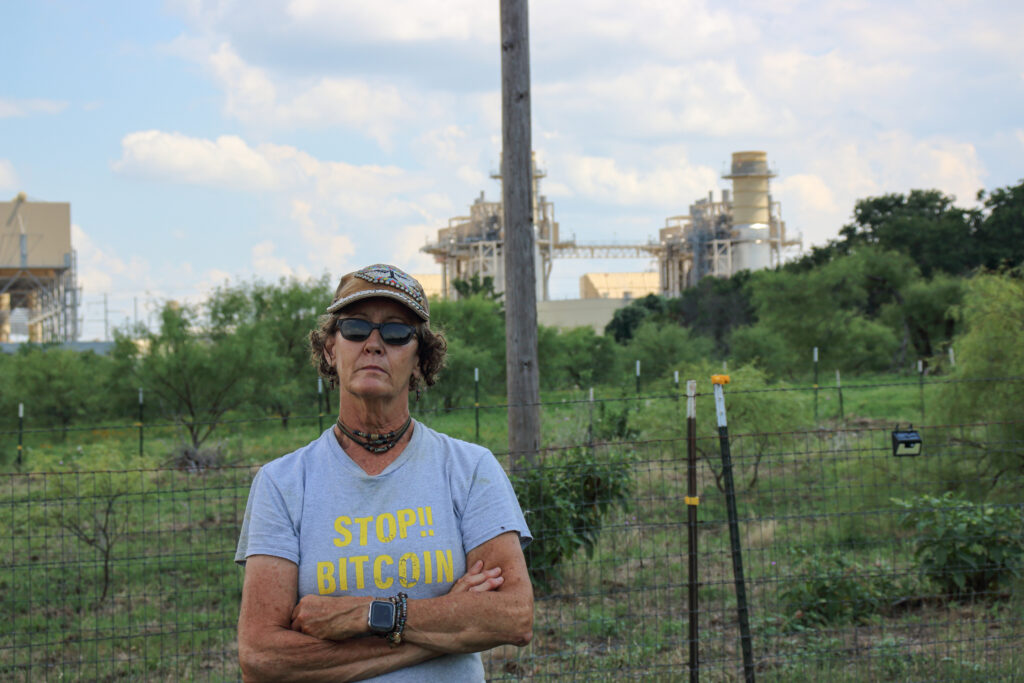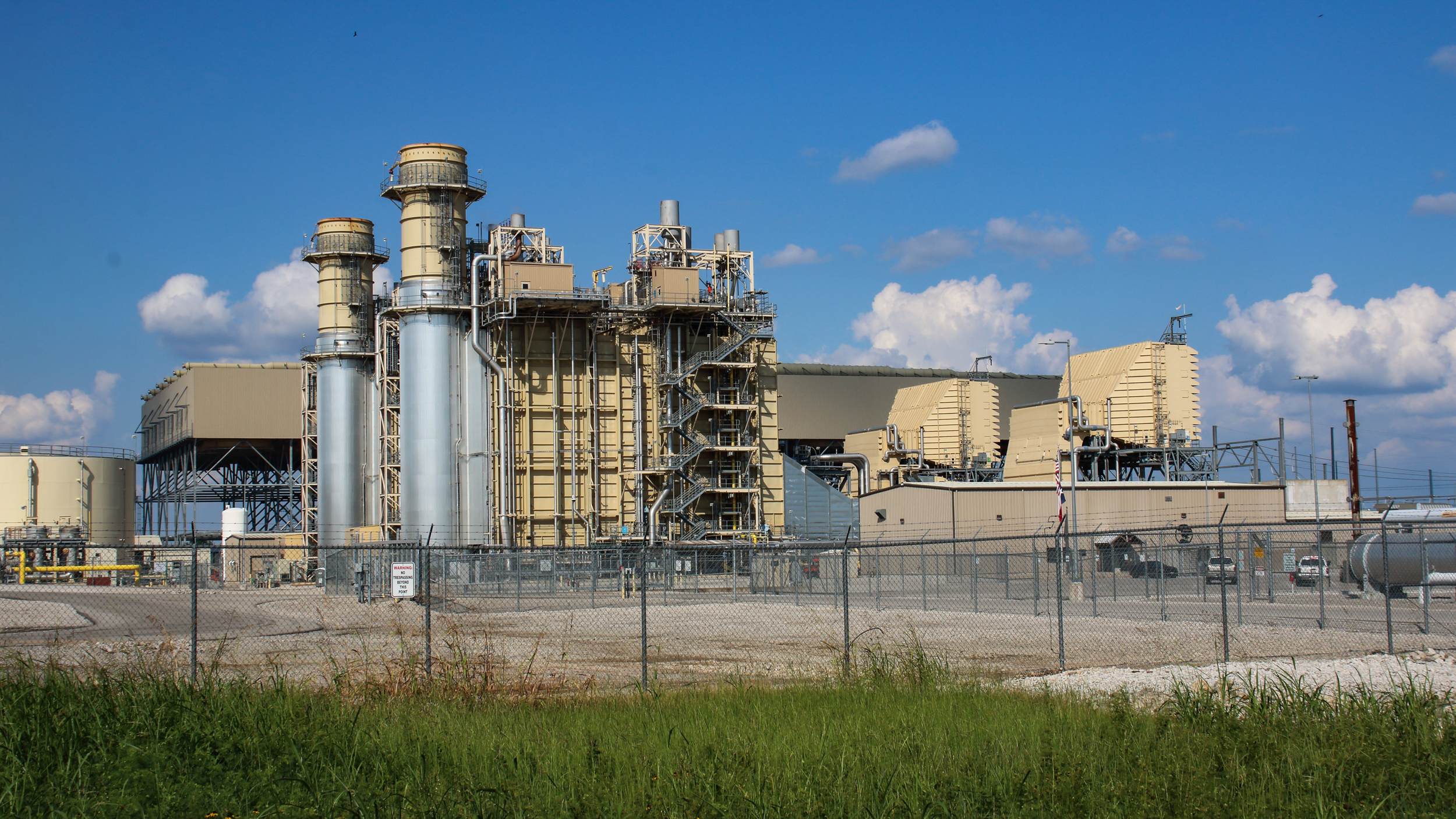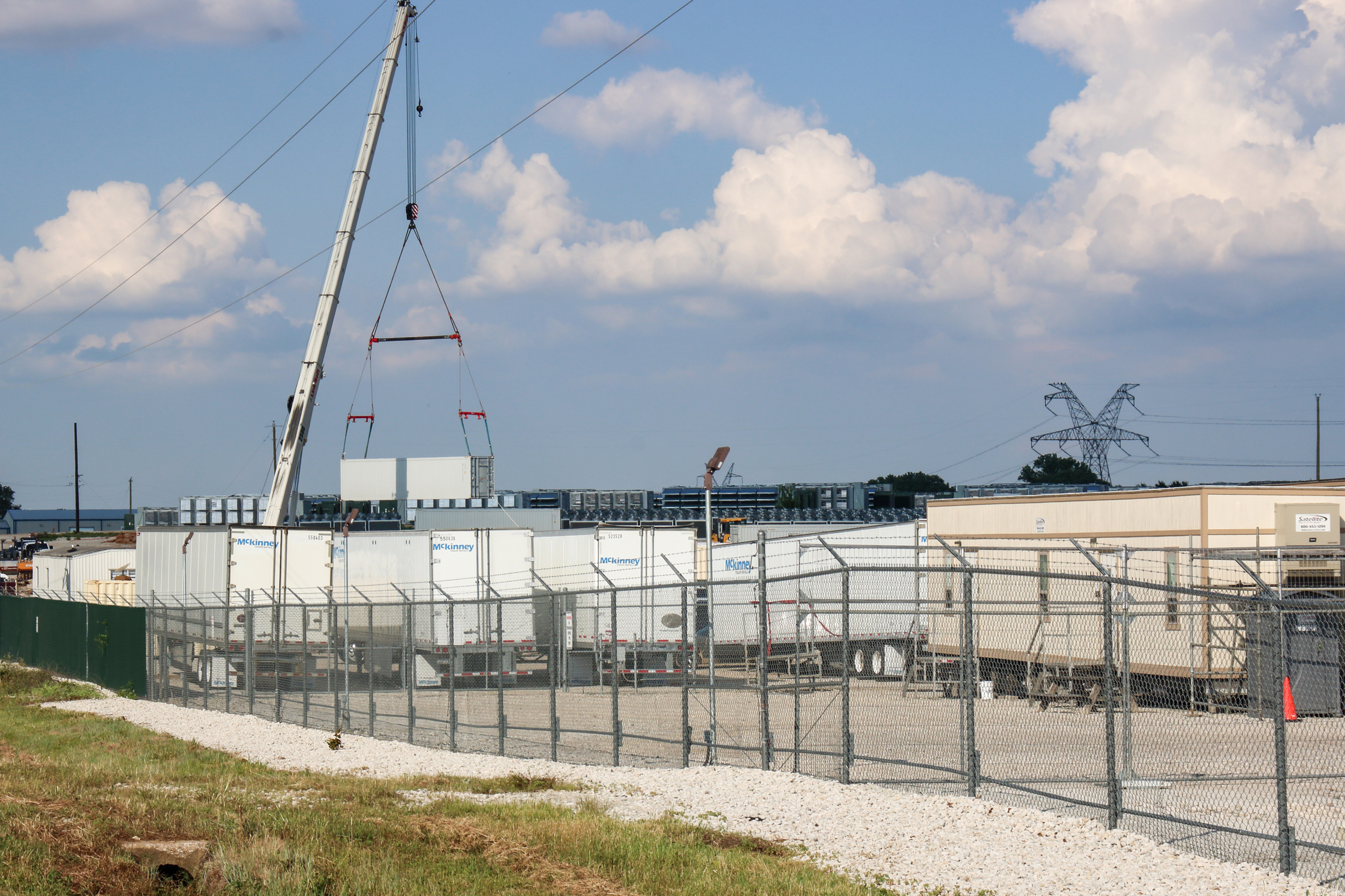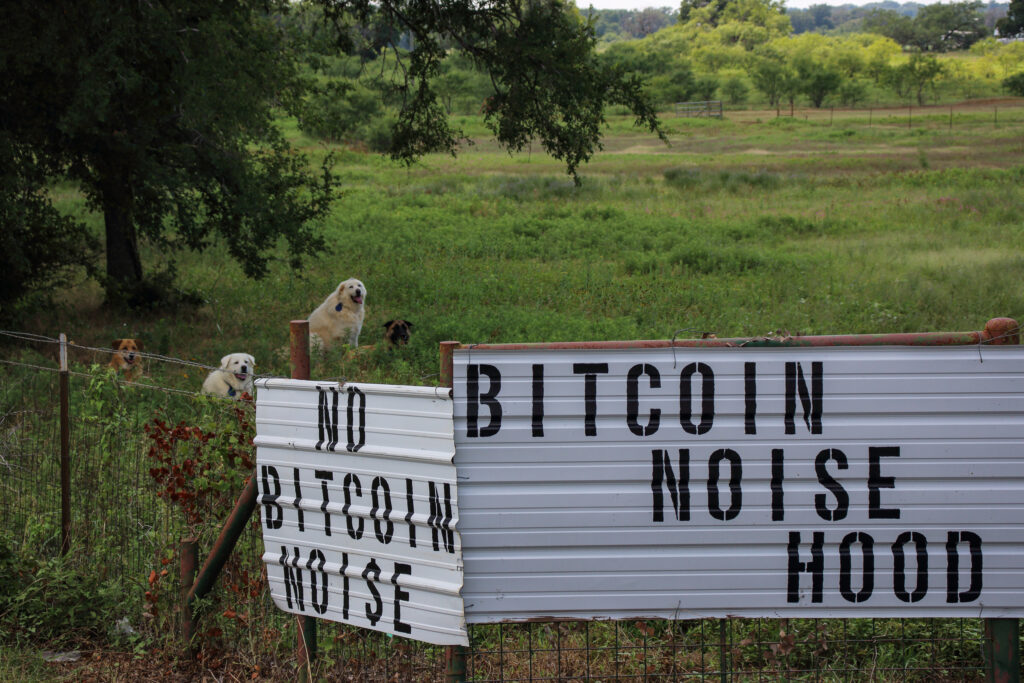Bitcoin
Texas Leaders Worry That Bitcoin Mines Threaten to Crash the State Power Grid

GRANBURY, TEXAS — Cheryl Shadden cannot sleep. The 61-year-old nurse, who works at hospitals giving patients anesthesia, says she is kept up at night by the nonstop mechanical whir of fans spinning to cool tens of thousands of computers.
Shadden lives in Granbury, Texas, about 40 miles southwest of Fort Worth, with her seven dogs, six horses, six cats and a parrot. In 2022, after 23 years in the area, Shadden got a new neighbor: a 300-megawatt Bitcoin facility, referred to as a “mine,” where computers run around the clock to help maintain a global network of transactions in the cryptocurrency.
“Nobody in their right mind would live here,” Shadden said. “My windows rattle. The sound goes through my walls. My ears ring, 24/7.”
Since the facility opened, Shadden said her animals are restless, and some of her dogs have pulled out their own fur. In late June, Shadden went to a doctor to get her hearing examined, and tests found she had suffered permanent hearing loss. She believes her animals’ behavior and her hearing loss were caused by the noise from the Bitcoin mine.
Cheryl Shadden stands in her backyard with several of her Great Pyrenees dogs. Credit: Keaton Peters/Inside Climate News
Noise pollution is not the only reason that Bitcoin mining may be keeping Texans up at night. The mine owned and operated by Marathon Digital is part of a growing tide of cryptocurrency mining facilities opening across the country, but especially in Texas, where taxes are low, land is plentiful and mining companies can take advantage of the state’s deregulated energy market. As electricity demand rises, ordinary Texans can end up paying the price on their monthly utility bills.
Bitcoin is the largest and best known cryptocurrency, first devised in 2008 as an electronic payment system that cuts out middlemen like banks and credit card companies, with all transactions managed by a decentralized network of Bitcoin users. A Bitcoin, currently worth about $58,000, can be purchased with dollars at a Bitcoin exchange, like Coinbase. To buy something with Bitcoin, a buyer sends the currency from a digital wallet to the seller’s digital wallet.
But it’s not that simple. A computer algorithm assigns each transaction a unique random identifying code, which must be guessed in order to validate the transaction. Bitcoin “mining” comes when companies operate powerful computers day and night running endless series of random numbers before hitting upon, or guessing, the correct code. Every time a Bitcoin miner’s computer successfully guesses a transaction code, the miner receives 3.125 newly minted Bitcoins (worth about $181,250 at the current price), which is the fee for helping maintain the network and keep it secure.
Explore the latest news about what’s at stake for the climate during this election season.
The system is designed so that it takes an average of 10 minutes for a Bitcoin miner somewhere in the world to guess a code and verify a transaction. But as Bitcoin miners add computing power to verify more transactions, the system’s algorithm makes the process harder by generating longer codes, creating what has been called an energy arms race, requiring larger and larger amounts of electricity to run the computers.
Texas is now home to 10 of 34 large Bitcoin mines.
During cold spells or heat waves, Texans are commonly called on to conserve power. For example, in August 2023, the state’s grid operator issued eight conservation requests, asking the public to reduce electricity use to help prevent an emergency in which rolling blackouts could be required. Increasingly, Texas lawmakers are worried that energy-hungry mines will make it harder to keep the lights on across the state.
“They’re going to put our grid at risk because of the power they’re drawing,” said state Sen. José Menéndez (D-San Antonio) at a public hearing on June 12.
For more than six hours, senators on the Business and Commerce Committee pressed grid operators, public utility commissioners and representatives from industries, including manufacturing, oil and gas and cryptocurrency. Chief among legislators’ concerns was the massive growth in energy demand on the state’s main electrical grid, which is estimated to go from a peak demand of about 85,000 megawatts last year to 150,000 megawatts in 2030, according to estimates from the Electric Reliability Council of Texas.
Following the hearing, in a post on social media, Lt. Gov. Dan Patrick declared, “it can’t be the Wild Wild West of data centers and crypto miners crashing our grid and turning the lights off.”
Power Plant Loans and “Large Flexible Loads”
Currently, cryptocurrency mining — mostly for Bitcoin — can draw up to 2,600 megawatts of power from the grid operated by the Electric Reliability Council of Texas, ERCOT’s senior vice president, Woody Rickerson, told senators. That’s about the same amount of power used by the city of Austin, and another 2,600 megawatts of mining is already approved to connect to the grid. Even more Bitcoin mines are expected to come to Texas in the near future.
ERCOT estimates that as much as 43,600 megawatts of additional electricity demand will be added to the grid by 2027 from facilities classified as “Large Flexible Loads” requiring more than 75 megawatts. In a statement to Inside Climate News, ERCOT said, “currently, the crypto mining industry represents the largest share of large flexible loads seeking to interconnect to the ERCOT System.” Data centers for artificial intelligence and facilities for producing hydrogen from water through electrolysis also make up part of the large flexible loads.
To meet the major growth in demand, driven in large part by Bitcoin mining, Texas is turning to natural gas power plants, with taxpayers providing the down payment. In 2023, the Texas legislature passed a loan program, later approved by voters as ballot Proposition 7, to give low-interest loans to companies to build or expand power plants. At first, the Texas Energy Fund will have $10 billion to award, after receiving more than $39 billion in requests.
 A view of the Wolf Hollow II power plant, owned by Constellation Energy, in Granbury. Credit: Keaton Peters/Inside Climate News
A view of the Wolf Hollow II power plant, owned by Constellation Energy, in Granbury. Credit: Keaton Peters/Inside Climate News
One of the companies applying for a loan is Constellation Energy, which owns the Wolf Hollow II power plant in Granbury. Constellation has an agreement with Marathon Digital, allowing Marathon to rent space next to the power plant for Bitcoin mining and purchase power directly from Wolf Hollow II.
Marathon has a capacity to use up to 300 megawatts of power, and Constellation wants to add additional turbines onto Wolf Hollow II capable of generating that much power.
In an application to the Texas Commission on Environmental Quality, Constellation said the power plant expansion would include eight turbines, and it applied for air permits to release more than 796,000 additional tons of carbon dioxide per year. Such massive greenhouse gas emissions have made cryptocurrency mining the focus of intense opposition by climate activists.
Bitcoin Can ‘Game the System’
The deal between Marathon and Constellation, known as a power purchase agreement, is part of what makes Bitcoin mines major players in the Texas energy market — not simply consumers of power. In most agreements, crypto facilities lock in a relatively low rate to purchase electricity “behind the meter,” so the supply does not enter the ERCOT market. But Bitcoin mining companies can later decide to sell that power to the rest of the grid through the ERCOT market, rather than powering their computers.
For example, Riot Platforms operates two of the largest existing Bitcoin facilities in the world, both located in Texas. The New York Times reported last year that Riot Platforms’ operation in Rockdale was the most power-intensive Bitcoin mining operation in the country, using “about the same amount of electricity as the nearest 300,000 homes.”
One of the facilities has been able to pay as low as 2.5 cents per kilowatt-hour of electricity, while the average price across Texas in 2022 was more than 10 cents.
 Trucks are parked alongside containers of computers owned by Marathon Digital at the Bitcoin mine in Granbury. Credit: Keaton Peters/Inside Climate News
Trucks are parked alongside containers of computers owned by Marathon Digital at the Bitcoin mine in Granbury. Credit: Keaton Peters/Inside Climate News
In August 2023, when energy prices were high amid scorching summer days, Riot Platforms made $24.2 million from reselling power purchased through their private agreements onto the wholesale energy market, almost tripling the $8.6 million the company made that month mining and selling Bitcoin.
“They can game the system in a few different ways for their profit,” said Mandy DeRoche, an attorney at the nonprofit Earthjustice, who has worked on cases involving crypto mines across the country.
Separately, Bitcoin companies can participate in demand response programs, in which the companies allow ERCOT operators to control the energy load of the facility and lower their usage to compensate for sudden outages or periods of high demand elsewhere on the grid. These situations arise most often during extreme weather. Companies get paid a premium by ERCOT for participating in demand response, and they get paid an additional fee each time their energy load is controlled through the program. Riot Platforms made $7.2 million from these programs in August 2023, according to a monthly earnings report.
“Texas has set up a system which allows crypto mining to be significantly advantaged,” said state Sen. Charles Schwertner (R-Georgetown), the chairman of the Business and Commerce Committee.
Those millions in profit don’t appear out of thin air, and consumer advocates are worried the burden falls on Texans such as Cheryl Shadden and her neighbors in Granbury. “The cost is passed directly on to ratepayers,” said Adrian Shelley, Texas director for the nonprofit Public Citizen. Bitcoin miners “are ideally positioned to manipulate the energy market in a way that will drive up prices for consumers.”
With three distinct ways to profit — energy-intensive computations to “mine” Bitcoin, selling power on the wholesale energy market or participating in demand response — each decision will impact the availability of energy for most of Texas. And which method miners choose is highly variable.
As DeRoche explains, “if the price of Bitcoin is fairly low, then there’s more incentive to turn off [their computers] in peak demand or in extreme weather.”
This year, the price of Bitcoin has soared to record highs and remained steadily around $60,000 since March, about twice as high as in August 2023. With the price up, DeRoche said it will be harder to predict whether miners will power down when energy becomes scarce.
A Phased Plan for Noise Pollution
From the industry perspective, Bitcoin advocates say the flexibility of mining operations makes the grid stronger. “We need more price sensitive loads on the grid, not less,” said Lee Bratcher, president of the Texas Blockchain Council, in an email to Inside Climate News. “By locating in rural areas with too much power and not enough transmission capacity to get that power to major population centers,” Bratcher said the cryptocurrency mining industry is using power that would otherwise go to waste.
He added that many mines operate at full capacity during the night when demand is low and power down “during high power demand times like during hot afternoons in the summer or winter cold snaps.”
Bratcher, as well as representatives from Marathon Digital and Constellation Energy, declined to be interviewed. In an email, Jim Crawford, chief operating officer for Marathon, also said that the company incentivizes wind and solar power generation by signing power purchase agreements with renewable energy generators.
This story is funded by readers like you.
Our nonprofit newsroom provides award-winning climate coverage free of charge and advertising. We rely on donations from readers like you to keep going. Please donate now to support our work.
“Without these commitments, many renewable energy projects might never reach completion,” Crawford said. Despite being located directly alongside a natural gas plant in Granbury, Marathon’s other facilities in Texas are located near wind power, and Crawford said, “we are contributing to the displacement of fossil fuel generation.”
However, DeRoche, who wrote a report on the industry that includes a section titled “Breaking Through the Bitcoin Myths,” points out that power purchase agreements “are all confidential and proprietary,” making it difficult to fact-check Bitcoin miners’ claims about renewable energy. “Many of these claims don’t hold water,” she said.
As for the concerns over noise in the Granbury area, Crawford said that in March, Marathon released a phased plan to reduce noise, but he is “unable to comment on this matter at this time.”
The phased plan started in April. It includes shutting off fans whenever computers are not being used and beginning the transition to liquid cooling, in which computers are immersed in a non-conductive liquid solution that silently absorbs heat.
A spokesperson for Constellation said in an email that they “have heard the community’s feedback about reducing noise” and are working with Marathon to solve the problem.
 Signs are displayed on the fence of Cheryl Shadden’s property in Granbury, Texas. Credit: Keaton Peters/Inside Climate News
Signs are displayed on the fence of Cheryl Shadden’s property in Granbury, Texas. Credit: Keaton Peters/Inside Climate News
A wall on the east side of the Bitcoin facility where it borders a small community of mobile homes was built to dampen the sound. But Shadden, who lives northwest of the mine, said the sound reverberates off the wall, and depending on atmospheric conditions, neighbors miles away hear the noise. Even with first steps taken by Marathon, she said the noise is as bad as ever.
Local law enforcement has cited Marathon more than 30 times for violating noise limits above 85 decibels. From the edge of Shadden’s property, her neighbor measured 87.9 on a decibel reader the same day that the Senate hearing took place. Neighbors have talked to local elected officials, but they say there hasn’t been any significant action resulting from those meetings.
“You certainly get the impression that there’s people that see this is just a great, you know, money opportunity for the county, right? And the health issues they haven’t gotten too concerned about,” said Granbury resident John Highsmith.
Neighbors are also taking aim at the power plant, and have complained to Constellation, arguing that it is putting the community at risk by renting to the Bitcoin mine. Separately, they are preparing for a hearing with the state environmental regulator in the fall to challenge the company’s plans to increase air pollution by expanding the power plant. Hood County residents, including one of the county commissioners, have also been pressuring the county not to renew Constellation Energy’s tax abatement.
“This community has had enough,” Shadden said.
Bitcoin
Bitcoin (BTC), Stocks Bleed as China’s Surprise Rate Cut Signals Panic, Treasury Yield Curve Steepens

Risk assets fell on Thursday as China’s second rate cut in a week raised concerns of instability in the world’s second-largest economy.
Bitcoin (BTC)the leading cryptocurrency by market cap, is down nearly 2% since midnight UTC to around $64,000 and ether (ETH) fell more than 5%, dragging the broader altcoin market lower. The CoinDesk 20 Index (CD20), a measure of the broader cryptocurrency market, lost 4.6% in 24 hours.
In equity markets, Germany’s DAX, France’s CAC and the euro zone’s Euro Stoxx 50 all fell more than 1.5%, and futures linked to the tech-heavy Nasdaq 100 were down slightly after the index’s 3% drop on Wednesday, according to the data source. Investing.com.
On Thursday morning, the People’s Bank of China (PBoC) announced a surprise, cut outside the schedule in its one-year medium-term lending rate to 2.3% from 2.5%, injecting 200 billion yuan ($27.5 billion) of liquidity into the market. That is the biggest reduction since 2020.
The movement, together with similar reductions in other lending rates earlier this week shows the urgency among policymakers to sustain growth after their recent third plenary offered little hope of a boost. Data released earlier this month showed China’s economy expanded 4.7% in the second quarter at an annualized pace, much weaker than the 5.1% estimated and slower than the 5.3% in the first quarter.
“Equity futures are flat after yesterday’s bloody session that shook sentiment across asset classes,” Ilan Solot, senior global strategist at Marex Solutions, said in a note shared with CoinDesk. “The PBoC’s decision to cut rates in a surprise move has only added to the sense of panic.” Marex Solutions, a division of global financial platform Marex, specializes in creating and distributing custom derivatives products and issuing structured products tied to cryptocurrencies.
Solot noted the continued “steepening of the US Treasury yield curve” as a threat to risk assets including cryptocurrencies, echoing CoinDesk Reports since the beginning of this month.
The yield curve steepens when the difference between longer-duration and shorter-duration bond yields widens. This month, the spread between 10-year and two-year Treasury yields widened by 20 basis points to -0.12 basis points (bps), mainly due to stickier 10-year yields.
“For me, the biggest concern is the shape of the US yield curve, which continues to steepen. The 2- and 10-year curve is not only -12 bps inverted, compared to -50 bps last month. The recent moves have been led by the rise in back-end [10y] yields and lower-than-expected decline in yields,” Solot said.
That’s a sign that markets expect the Fed to cut rates but see tighter inflation and expansionary fiscal policy as growing risks, Solot said.
Bitcoin
How systematic approaches reduce investor risk

Low liquidity, regulatory uncertainty and speculative behavior contribute to inefficiency in crypto markets. But systematic approaches, including momentum indices, can reduce risks for investors, says Gregory Mall, head of investment solutions at AMINA Bank.
Low liquidity, regulatory uncertainty and speculative behavior contribute to inefficiency in crypto markets. But systematic approaches, including momentum indices, can reduce risks for investors, says Gregory Mall, head of investment solutions at AMINA Bank.
Low liquidity, regulatory uncertainty and speculative behavior contribute to inefficiency in crypto markets. But systematic approaches, including momentum indices, can reduce risks for investors, says Gregory Mall, head of investment solutions at AMINA Bank.
July 24, 2024, 5:30 p.m.
Updated July 24, 2024, 5:35 p.m.
(Benjamin Cheng/Unsplash)
Fuente
Bitcoin
India to Release Crypto Policy Position by September After Consultations with Stakeholders: Report

“The policy position is how one consults with relevant stakeholders, so it’s to go out in public and say here’s a discussion paper, these are the issues and then stakeholders will give their views,” said Seth, who is the Secretary for Economic Affairs. “A cross-ministerial group is currently looking at a broader policy on cryptocurrencies. We hope to release the discussion paper before September.”
Bitcoin
Bitcoin (BTC), Ether (ETH) slide as risk aversion spreads to crypto markets

Ether, the second-largest token, fueled a slide in digital assets after a stock rout spread unease across global markets.
Ether fell about 6%, the most in three weeks, and was trading at $3,188 as of 6:45 a.m. Thursday in London. Market leader Bitcoin fell about 3% to $64,260.
-

 Videos9 months ago
Videos9 months agoBitcoin Price AFTER Halving REVEALED! What’s next?
-

 Bitcoin8 months ago
Bitcoin8 months agoBitcoin Could Test Record Highs Next Week in ETF Flows, Says Analyst; Coinbase appears in the update
-

 Videos9 months ago
Videos9 months agoAre cryptocurrencies in trouble? Bitcoin Insider Reveals “What’s Next?”
-

 Videos9 months ago
Videos9 months agoCryptocurrency Crash Caused by THIS…
-

 Videos8 months ago
Videos8 months agoThe REAL reason why cryptocurrency is going up!
-

 Altcoin8 months ago
Altcoin8 months agoThe best Altcoins to buy before they rise
-

 Videos9 months ago
Videos9 months agoBlackRock Will Send Bitcoin to $116,000 in the Next 51 Days (XRP News)
-

 Videos9 months ago
Videos9 months agoDonald Trump: I like Bitcoin now! Joe Biden HATES cryptocurrencies.
-

 Videos8 months ago
Videos8 months agoSolana Cryptocurrencies: the future WILL SHOCK you | What comes next?
-

 News9 months ago
News9 months agoTON, AKT, AR expect increases of 15%+ as the market stabilizes
-

 Videos8 months ago
Videos8 months agoBitcoin Whale REVEALS: The 5 Best Coins to Make You a Millionaire!
-

 Videos8 months ago
Videos8 months agoBREAKING NEWS: The 19 best cryptocurrencies ready to skyrocket!






